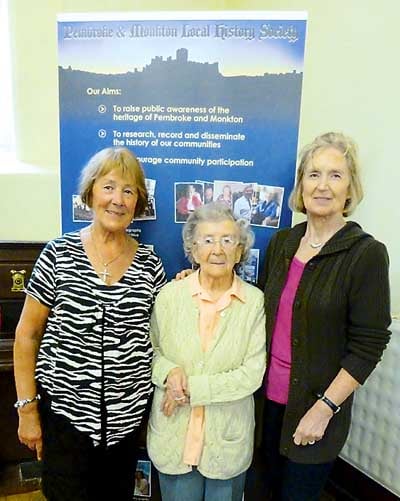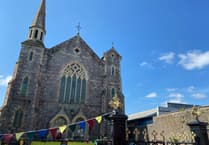St. Anne
St. Anne's is the western most part of Pembroke. It was once the site of a chapel and is marked on old maps, but the chapel has long gone leaving only its name. A house was built on or very close to the site and this was demolished recently having fallen into dereliction. There are people living locally who once lived there and one of these is Dorcas Thoburn (nee Russan) who lived there with her mother during the war years, whilst her father was away at sea. Dorcas is a very interesting lady to talk to - and humorous with it - not surprising really as both her parents were amazing characters. She has written this for us:
Tommy Russan
"I had bought a pup from an old man called Captain Tom (he lived in a small cottage which was knocked down to build the Catholic Church in Pembroke). I called the pup Chum after the name of a ship my father was on, the Chumleigh. He then changed to a ship called Pencarrow and was on the North Atlantic conveys and then to the Mediterranean, later being diverted to help in the evacuation of Dunkirk to pick up survivors. And who should be the second man he pulled on board? Fred Mayhew from Milford Haven! "What are you doing here?" he said. "Pulling you out of a mess as usual" dad replied.
He returned home about the middle of May. By now my pup had become a mother and the new pup was called Penny after that ship. My father had been at sea all his life but Dunkirk and the North Atlantic had shaken him somewhat so a friend of his got him a start in the Ordinance in Pembroke Dock making guns and tanks. He was a man of 50.
The first day he came home he was amazed that they had issued him with a white boiler suit. He had never worn a white one during his life as he had been an engineer in coal boilers and it did nothing for him. He stayed at the Ordinance two weeks and came home complaining he could stand no more of his workmate's talk of gardening, pigeons and rabbit catching.
On the second Friday, he told the supervisor he was leaving. He was told he could not leave as he was an engineer in a reserve occupation, but he repeated he was going. The supervisor told him if he left he would have the police arrest him on Monday morning - "That's fine," said my dad "tell them to look for me 150 miles west of Ireland. If some of us don't go back to sea, you will be pushing those guns and tanks up the hill as you will have no fuel to put in them."
He left and went to Liverpool to join a ship to go back on the American convoys and didn't come back ashore for two years. Incidentally - Dorcas is popularly known as Togi. Why? - did you guess? Named after another of her father's ships, Togimo.
An unusual childhood
Now Dorcas had a very unusual childhood. Not only her father, but her mother took to the sea.
"My dad would come home and perhaps he'd be at home for two or three months and mother would be moaning when he'd got a ship so he said -"you ought to get yourself a ship and try it". A friend of hers came home who'd got a job as laundry manageress on the Empress of Britain and my mother went back with her, joined the Canadian Pacific and was on a world cruise for six months. I then went to live with my grandmother at Littlehaven. When my father came home and asked my gran (who was not that fond of him) "where's Docie?" my grandmother with a big smile said "China." "What's she doing in China?" "You should know you go there often." And that was that.
In charge of the Guard
"My father would be up in Liverpool - I would travel up there in the train in the charge of the guard and I'd have a twirl in Liverpool and stay at the Adelphi. When the ship was in, we would go to Lewis and Lewis and book it to whatever ship he happened to be on and this would last for about four days - "you'd better go home now the money's running out" he'd say and I'd be put on the train home and he would go down to the seaman's mission. He would move from a five star hotel to John Cory's mission at a shilling a night with no second thoughts in this world.
"But then my mother would come into Southampton and off I'd go to Southampton in the charge of the Guard and go down to have a look at the ships there."
Captain John Russan
Dorcas has been most helpful to me in my researches into Pembroke's past and she is a valued contributor to the 'Through My Eyes: a community history of Pembroke and Monkton' project that we are currently engaged in. Through her we have a connection to Pembroke's maritime past.
"My father's people came from Dale," Dorcas told me, "he was the son of Captain John Russan who owned sailing ketches that used to come up to Pembroke: he owned four or five ships, the Garlandstone being the most well-known of them. His wife was Frances Hurlow from Nash and they had two other sons Jack Russan and Peter Russan who also went to sea with him. They all served on the Garlandstone, but father left to join the Merchant Navy.
"Captain Russan used to do quite a lot of trade to Jersey up the Cleddau River to Landshipping, Cresswell Quay, Pembroke, Bristol ...all up the Bristol Channel carrying cargoes of corn, potatoes, lime, chicken feed, coal whatever was on demand."
The Garlandstone
The sea was once Pembroke's life blood and the town grew rich on the back of its maritime trade. In the mid-19th century the railway largely replaced shipping as the main conveyor of goods, but the sea continued to act as a main highway for trade well into the 20th century. Boats like Garlandstone would continue in the coastal trade calling into Pembroke to discharge their cargos. The ketch alongside the North Quay in the lovely photograph printed here could possibly be Garlandstone. Taken by Len Haggar, it is reproduced here by permission of the Haggar family.
When Dorcas told me that Garlandstone was still in existence, my husband Stuart and I decided to pay a visit to Morwellham Quay, Devon, where we saw her moored off the quayside. She was actually built only a mile or so away from Morwellham Quay, at Calstock. Built in 1909, she was the last wooden merchant sailing vessel except one to be built in Southern England and, after her launch, Captain Russan sailed her to the Port of Milford Haven where she was registered on January 27, 1909, her official date of birth. A fascinating place and well worth a visit, Morwellham Quay is a story of Victorian boom and bust. It rose to become the greatest copper ore port in Queen Victoria's empire, but came to a catastrophic end when the copper ran out and lay deserted until revived as a living history museum. And so it was Garlandstone came to be at Morwellham Quay, gifted to them by the National Museum of Wales which formerly owned it.
Next event
Tonight (Friday, October 19), we have another of our popular quiz nights at Monkton Priory Church Hall, 7.30 pm. £3.50 includes a lovely buffet - bring your own bottle if you wish.





Comments
This article has no comments yet. Be the first to leave a comment.